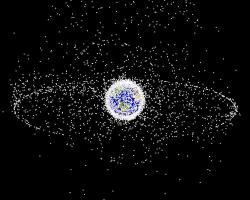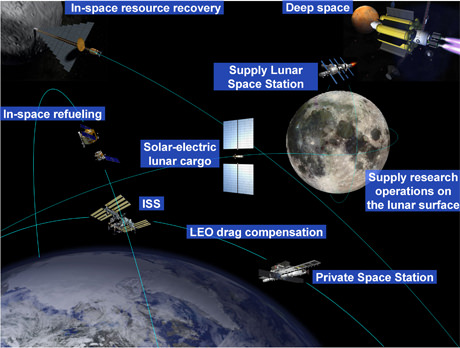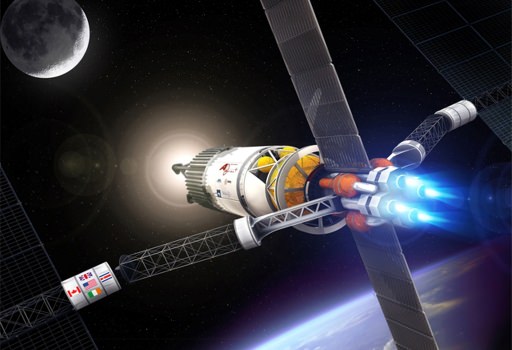[/caption]
Franklin Chang Diaz’s proposed VASIMR rocket engine could create very versatile spacecraft. Not only does the plasma-fueled rocket have the potential to make a trip to Mars in just over a month, it could also help clean up space trash in Earth orbit. “Our goal is to be able to have a garbage truck that will be picking up all of these objects at various orbits,” astronaut Chang Diaz said in an article in the Global Post. The debris could put into an “orbital graveyard,” he added, “or we could actually launch them to the sun and drive them to the sun, which is kind of the ultimate, cosmic dump.”

Space debris is becoming a growing problem. The number of non-operating satellites in orbit has increased, as well as debris from spacecraft explosions and, as happened earlier this year, collisions between satellites.
“The Earth has become virtually a beehive,” Chang Diaz said. “The number of satellites orbiting the Earth, we’re talking hundreds of thousands of these objects. Some of them are just junk that’s floating there simply because these satellites have run out of fuel and they just remain in orbit dead.”
The rocket, called the VASIMR for “variable specific impulse magnetoplasma rocket,” uses a high-power technology initially studied by NASA that turns argon into plasma. Propelled by an exhaust gas at temperatures close to that of the sun, the VASIMR VX-200 engine would have the ability to change orbits and accelerate and decelerate in order to pick up space debris.
In September, Chang Diaz’s company, Ad Astra, tested the rocket and achieved a milestone. During the a test on in a vacuum chamber on Earth, the engine cranked at just over 200 kilowatts, becoming the world’s most powerful electric rocket.

VASIMR is not suitable to launch payloads from the surface of the Earth due to its low thrust to weight ratio and its need of a vacuum to operate. It would, however be ideal to function as an upper stage for cargo, drastically reducing the fuel requirements for in-space transportation.
Ad Astra has also signed an agreement with NASA to test a 200-kilowatt VASIMR engine on the International Space Station in 2013 to help keep it in orbit. ISS boosts are currently provided by conventional thrusters, which consume about 7.5 tons of propellant per year. By cutting this amount down to 0.3 tons, Chang-Diaz estimates that VASIMR could save NASA millions of dollars per year.
Other uses of the plasma rocket engine would be lunar cargo transport, human missions to Mars or other destinations, and in-space refueling.
Sources: Global Post, Ad Astra


Do you know what would be great? In case they go the orbital graveyard way (not so sure it’s a good idea; these things will have a tendency to drift away and it’d just postpone the problem… better than nothing, though)?
To build the thing in such a way that it could be refuellable, and then either sending up a new fuel load when it’s needed, or using the ISS as a refuelling station.
In fact, sooner or later, we’ll need purely orbital transfer ships, and to have them we’ll need to refuel them up there. This looks like a great candidate for that.
Sounds like Planetes for real, awesome 😀
As far as ‘dropping rubbish into the Sun’ is concerned it’s important to remember that it is a long way ‘down hill’ gravitationally and so the delta v that is required is huge (reaching Pluto is a walk in the park by comparison). For LEO junk it makes much more energetic sense to drop it back into our atmosphere where it will burn up harmlessly. Only really huge or dense material would reach the surface. For other orbits it would probably make sense to put together a parcel’ of junk that can be steered harmlessly past the lower orbits and back to the atmosphere. I love the idea of making this a refuelable system, so long as the supply ship is either reusable or at least carries sufficient propellant to dispose of itself responsibly!
If we’re constructing stuff in orbit then all those dead satellites are potential resources!
As Hawkwind sang in 1994:- “They call me Sputnik Stan / Space-ways maintenance man / I see a satellite about to fade / Got to collect / Weigh it in, and get paid…. ” ;-0
We could send the junk to the Moon.
In this case we could collect them and reuse the materials for moon bases.
You guys are awesome! YES, let us not waste anything in orbit but collect it and save until we can use it! Even nuclear waste could be too valuable to throw into the sun. I mean I would all for getting out of this biosphere if there was a foolproof method but once in space, then I would say reprocess it and use it.
Still, if there was something you really need to get rid of (some isotope with no hope of beginning usable) then using the VASIMAR to setup some gravity-assist with Venus and Mercury might help shed all that delta-V.
35,000 miles an hour is a lot to lose!
Plasma propulsion actually has engineering and laboratory confirmation and prototypes have actually been built and tested.
Plasma propulsion works.
This is the future of space propulsion systems.
On the other hand, so-called “black hole” propulsion is pure fantasy.
Interesting to note the fantasy propulsion system has many more comments in the comment section than the real propulsion system.
(Universe Today deserves credit for putting the two posts in juxtaposition.)
I suggest that is symptomatic of many in conventional astronomy — fantasy is more interesting and apparently important than reality.
And explains why fanciful concepts like “black holes” get so much traction. There is a persistent strain in the human psyche that prefers the reification of fantasy as opposed to grappling with the mundane thorns of reality.
It would seem that the commenters are oblivious to this irony (such is their attraction to fantasy over reality).
And the two posts in juxtaposition and their comment sections confirm this analysis,
I agree, This propulsion system has a bright future
There is a range of propulsion systems which exist or might exist. A little bit of physics is in order to understand how these are categorized.
Newton’s third law tells us that
d(mv)/dt = 0.
If we break this into bits in time increments we have
mdv + Vdm = 0
for an object throwing matter out the back. This is then Vdm/m = dv, for V the velocity of the stuff thrown out the back (exhaust plume), and dv an increment in the larger body (rocket). Integrating this gives a log
v = V*log(m_i/m_f)
for m_ i the initial mass of rocket plus fuel, and m_f the final mass when the fuel is used up. This is a tough reality, for logarithms grow slowly for large arguments. To get a rocket to travel 2.3 times the velocity of the gas in the rocket plume the ratio of M_i/M_f = 10. That is why you had a towering 360 foot rocket launch to the moon with only a small capsule the size of an SUV return.
The critical thing is the plume velocity V. A measure of this is specific impulse, which is the ratio of the plume velocity and Earth’s surface gravity g = 9.8m/s^2, s = V/g in units of seconds. Solid propellant rocket have I ~ 100-200sec, a liquid propellant rocket is about 450sec. Of course multiplying by g gives the plume gas velocity. This is largely where current rocket technology lies. Now the page Dawn Takes up Residence in Asteroid Belt here on UT
http://www.universetoday.com/2009/11/16/dawn-takes-up-residence-in-asteroid-belt/
discusses the craft Dawn, which has an ion propulsion unit. Ion propulsion is the latest advance in higher specific impulse propulsion, I = 1000sec. The system then does not need to carry as much reactive mass and can be solar powered. The drawback is that the flux of reactive mass ejected out the back in the plume is low, so the thrust is low. Ion propulsion is used for low thrust applications for maneuvering and station keeping. In principle though an ion propulsion system could change the velocity of a craft (delta-vee) to 20km/sec.
There is then the VASIMR, which is a radio frequency driven plasma propulsion system. This has a variable specific impulse from 1000sec to 30,000 sec. There is a reciprocal relationship between the specific impulse and the thrust however. Further, for higher thrusts you will have to power this craft with a nuclear reactor, and a real nuclear reactor and not one of the RTG units applied to run electronics on deep space missions. A VASIMR craft could reach a velocity of several hundred km/sec.
There are nuclear propulsion systems, hard, liquid and gas core reactors. These are comparable to the VASIMR performance, though gas core reactors could have I = 10,000 sec. A gas core reactor would though be touchy and dangerous. For higher specific impulse micro nuclear bomb detonation are required. This approach could reach I = 100,000 sec. One suggestion was the Daedalus craft, which is a spacecraft version of the laser inertial fusion confinement system. This craft could reach several percent the speed of light, and this was suggested as a possible star-probe system. I think photon driven sails are more practical for this, but … . We are now approaching relativistic rocket physics.
What is the ultimate specific impulse? It is due to photons being shot out the back at V = 3e^{8}m/sec, or s specific impulse of 3e^{7}sec. This is of course hard to arrange, for one needs some process for converting matter directly into energy. That is where the black hole drive comes in. The black hole, or vacuum physics involving virtual black holes or related concepts, could turn matter directly into energy and drive a craft at the largest specific impulse possible. This would also likely be modified to a specific impulse less than this where reactive propellant mass would absorb the hard gamma ray photons and provide a shield against this radiation. I worked some of this out and got a reasonable I = 1e^{7}sec. This sort of craft would reach low gammas ~ 2 or v = .8c.
For higher velocities one would need to combine this with the Bussard ramjet. In that setting with such high specific impulses exceedingly high relativistic velocities could be reached.
Lawrence B. Crowell
Anaconda Says:
November 21st, 2009 at 7:47 am
*Yawn*. Boring and trivial as always.